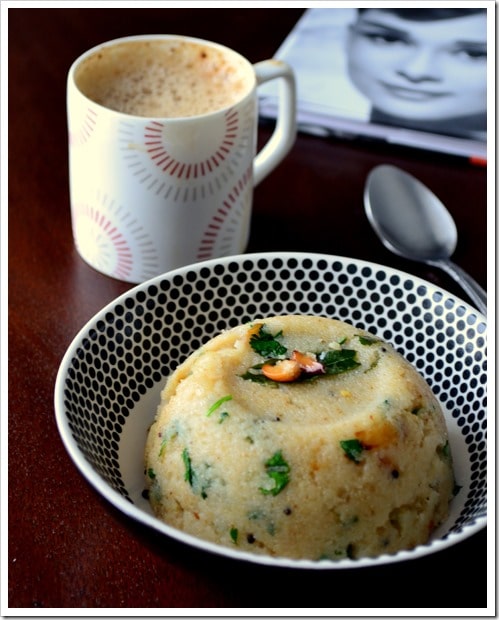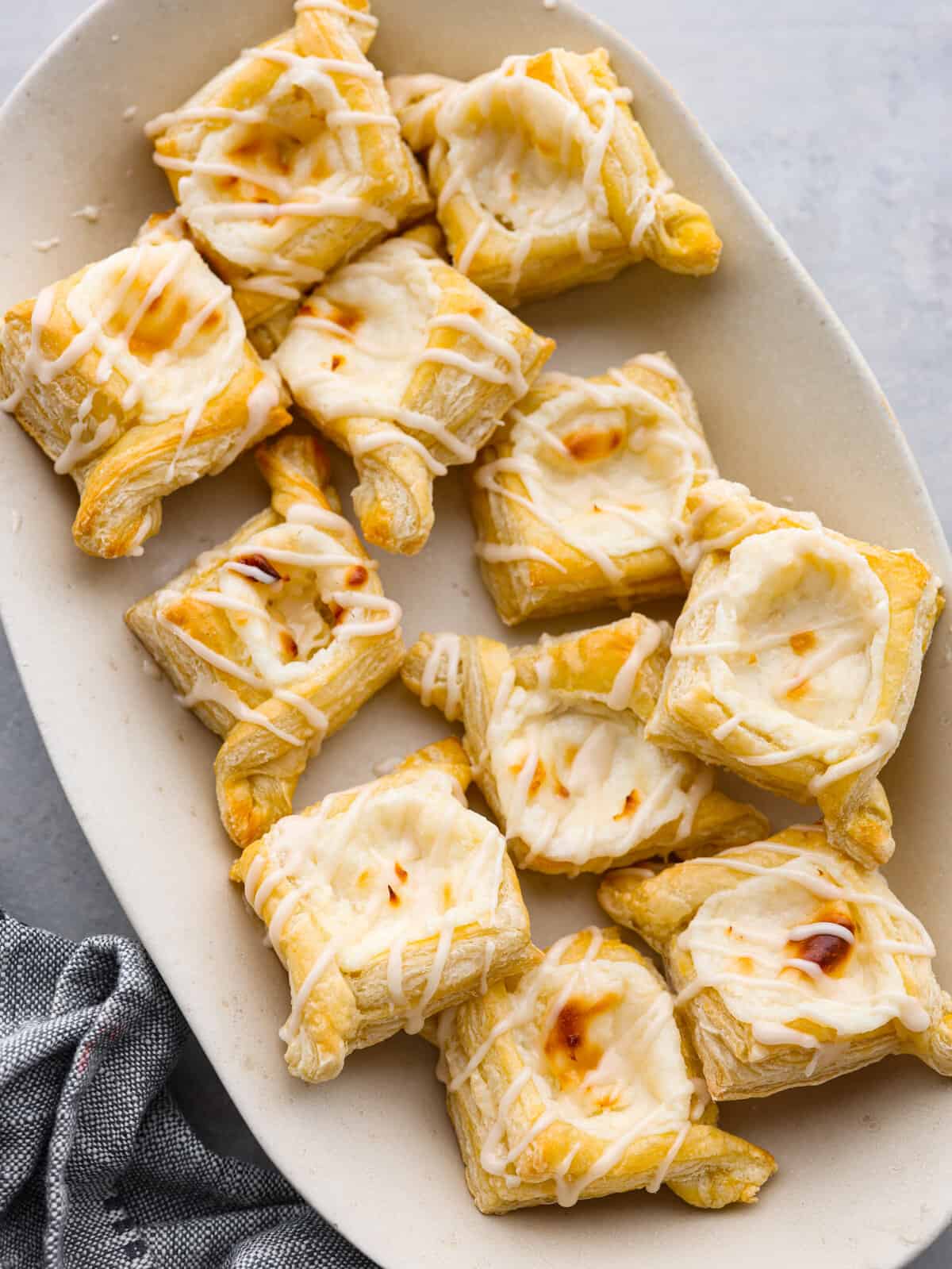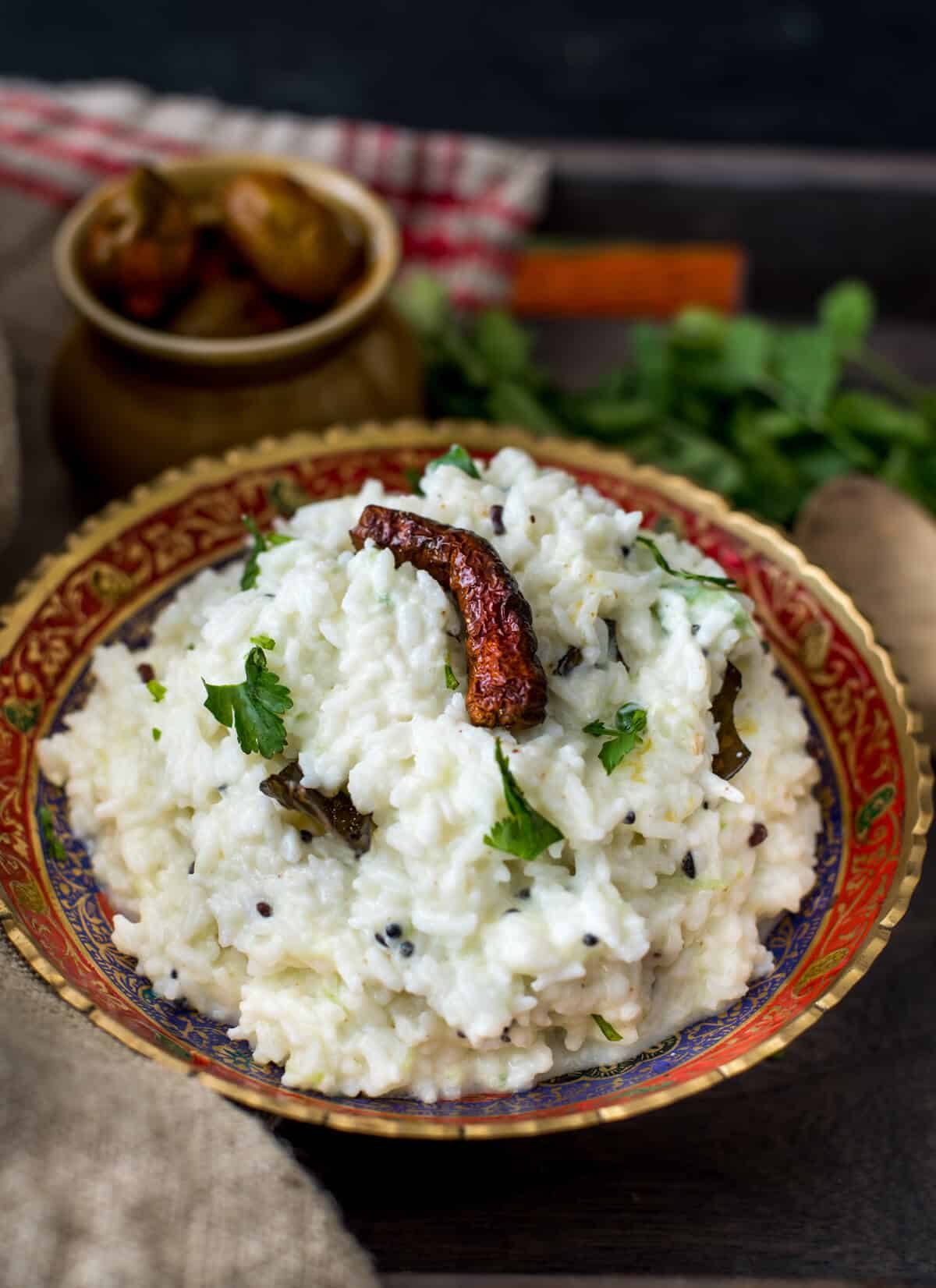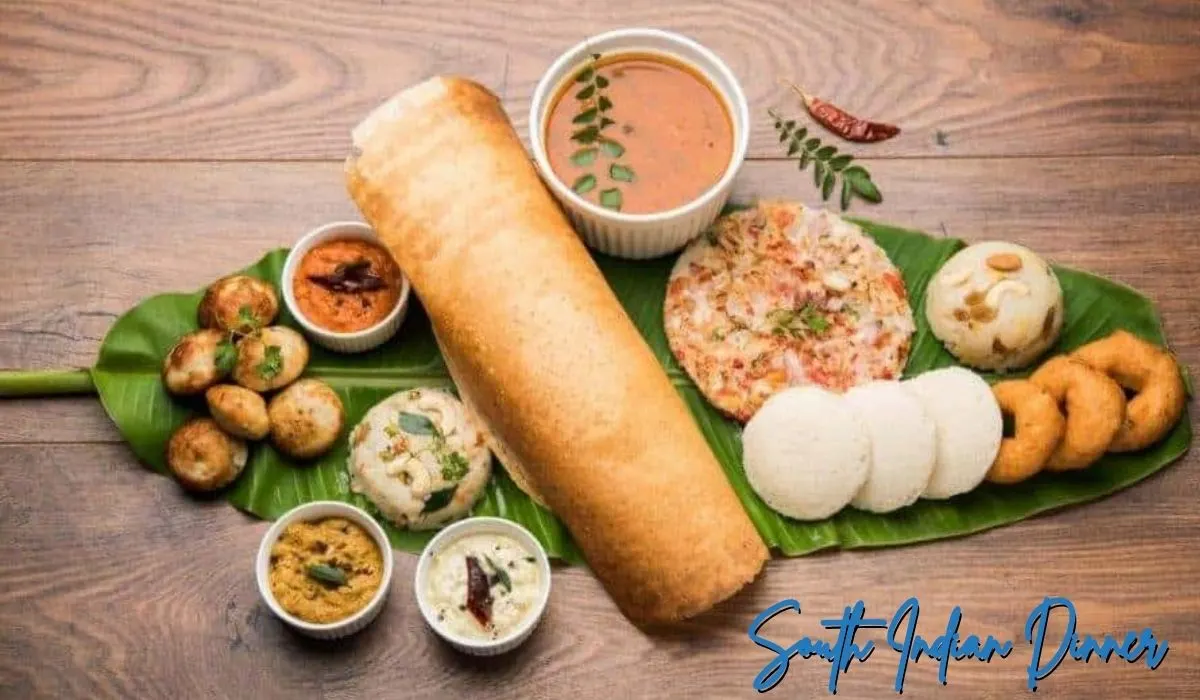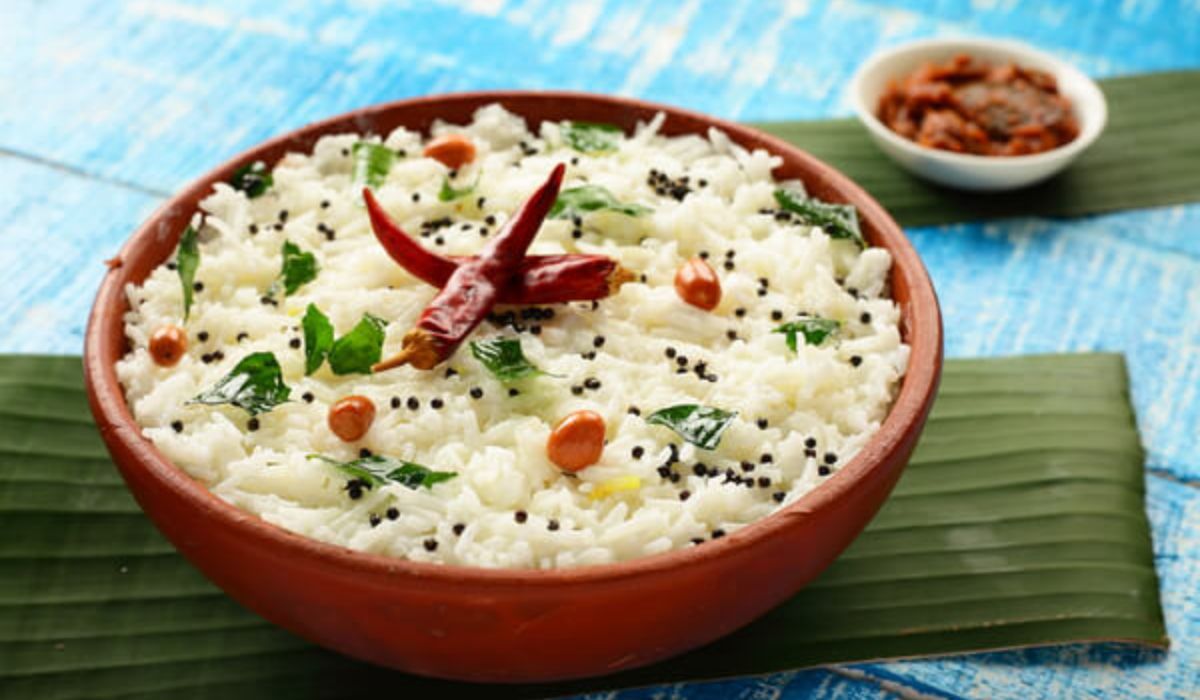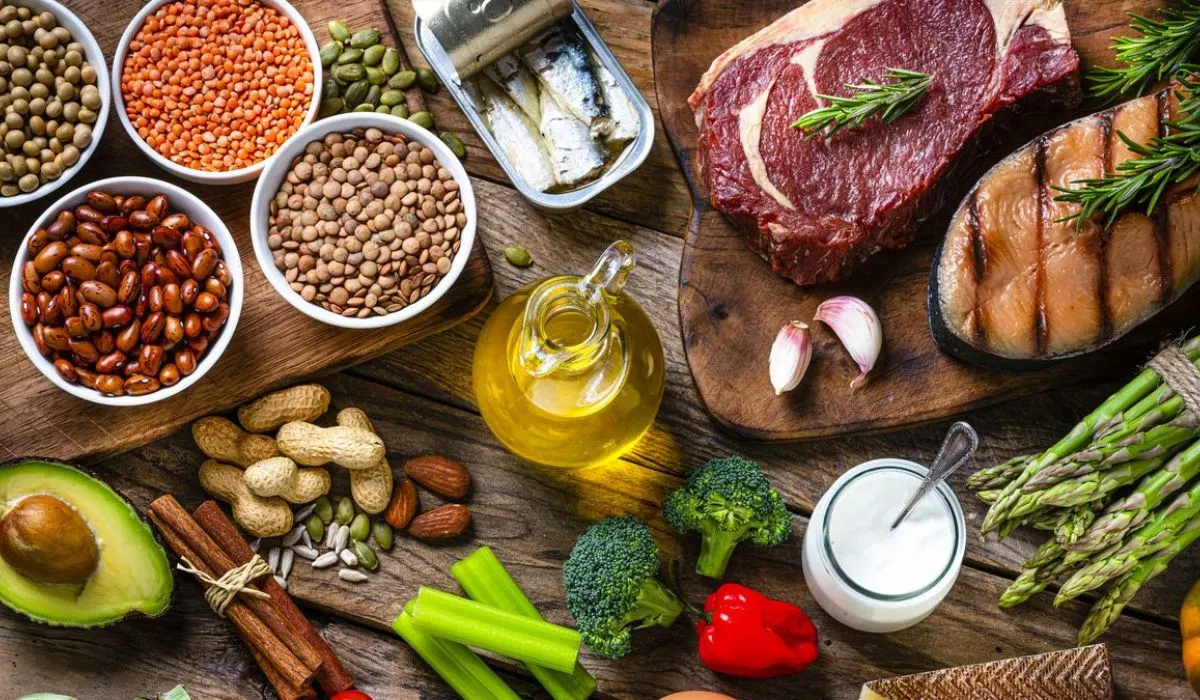If you are looking for a South Indian rava upma recipe that is soft, moist and melts in your mouth, just like the ones served in Udupi restaurants, then you are at the right place.
Ready in 20 minutes, this succulent semolina-based breakfast dish makes for a filling and satisfying meal when paired with coconut chutney and sambar.
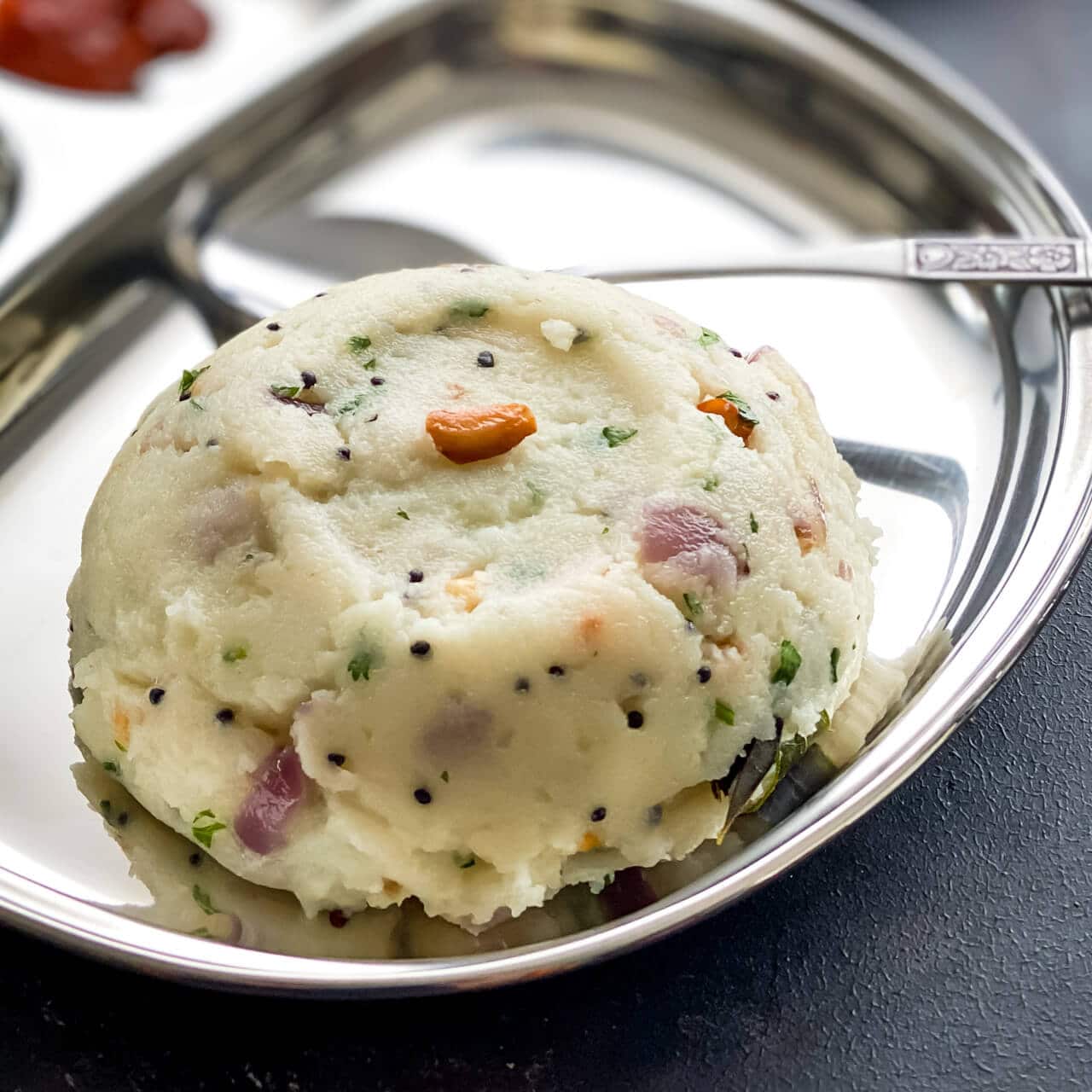
What is upma
Upma is a popular South Indian breakfast/snack dish made from semolina or surf of wheat. Semolina is tabbed rava in most South Indian homes, whereas in Northern India, it is popularly tabbed sooji or suji.
For those who never had rava upma, think of it as a savory porridge made from semolina as its key ingredient. It is made by roasting semolina till it turns aromatic, which is then cooked in humid water. The savor in this dish comes from the wing of sauteed onions, untried chilies, and the tempering of mustard seeds, urad dal, chana dal, and curry leaves.
While upma is often served as breakfast or snack in South India and Maharashtra, you can pack it for school/office lunch too. It makes for a filling meal when loaded with veggies.
The fact that it is easy to melt and takes very little time is moreover one of the reasons why it is a popular item to serve in hostels and large gatherings.
History of the recipe
Though the origin of this scrumptious dish is shrouded in mystery, it is probably a modified version of a simple meal that widows used to eat in the days of yore. The widows were not supposed to have salt or spices, so they used to eat rava cooked in water for dinner.
Over the centuries, it probably evolved into a quick and succulent snack between meals and into the upma that we know.
Upma is known by many variegated names wideness the country. It is tabbed Kharabhat and Uppittu in Kannada, Uppumavu in Tamil, Uppindi in Telugu, and in Marathi, it is tabbed Uppeet, but the most wontedly used name is upma, rava upma, suji ka upma.
It is believed the name is derived from the word uppu – which in many South Indian languages is the word for salt and mavu, which is the word for flour.
What is rava / semolina?
Semolina (rava / rawa) is the coarse flour made from the endosperm of durum wheat – a particular variety of wheat. While the rest of the world uses semolina flour in pasta, porridge, and bread, Indians love it to make savory and sweet dishes such as –
- Rava laddoo – sweet, crumbly balls made from semolina that are a hot favorite with folks of all ages!
- Suji ka halwa – Crumbly, sweet, and succulent – that’s how you would describe sheera, moreover known as suji ka halwa. Learn how to make this simple and traditional dessert in less than 30 minutes.
- Rava idli – Enjoy hot, soft, and fluffy idlis unendingly with this easy instant rava idli recipe.
How is semolina variegated from whole wheat flour?
I know semolina sounds very similar to whole wheat flour, but it is not. To understand the difference between the two, you need to understand the variegated parts of the wheat kernel.
A wheat kernel has three edible parts – bran(outer skin rich in webbing and antioxidants), endosperm (the largest part of the kernel that contains starchy carbs and proteins), and germ (the embryo which contains healthy fats, proteins, vitamins, and minerals).
The difference between whole wheat flour (atta in Hindi) and semolina is that atta is made from the unshortened wheat kernel (including the bran, germ, and endosperm), while rava is made only from the endosperm.
Since fiber, vitamins, and minerals are lost during the processing of durum wheat to make semolina, manufacturers often add nutrients to create an enriched semolina product that has a higher webbing and protein content.
Is semolina (rava) healthy?
Here’s why enriched semolina is good for you –
- Supports heart health – Semolina contains nutrients like folate and magnesium that are considered heart-healthy.
- Boosts energy – Enriched semolina is rich in micro-nutrients, minerals, and vitamins like thiamine and folate that help energy production.
- Keeps you from snacking – Being rich in protein, semolina takes longer to rewording and keeps you satiated for a long time lamister unnecessary snacking.
Here is an informative vendible to spruce up your knowledge on semolina – its nutritional value and health benefits.
What kind of rava to use in upma?
Upma is typically made from Bombay rava (the coarser kind of rava), but you can moreover use Bansi rava (fine semolina).
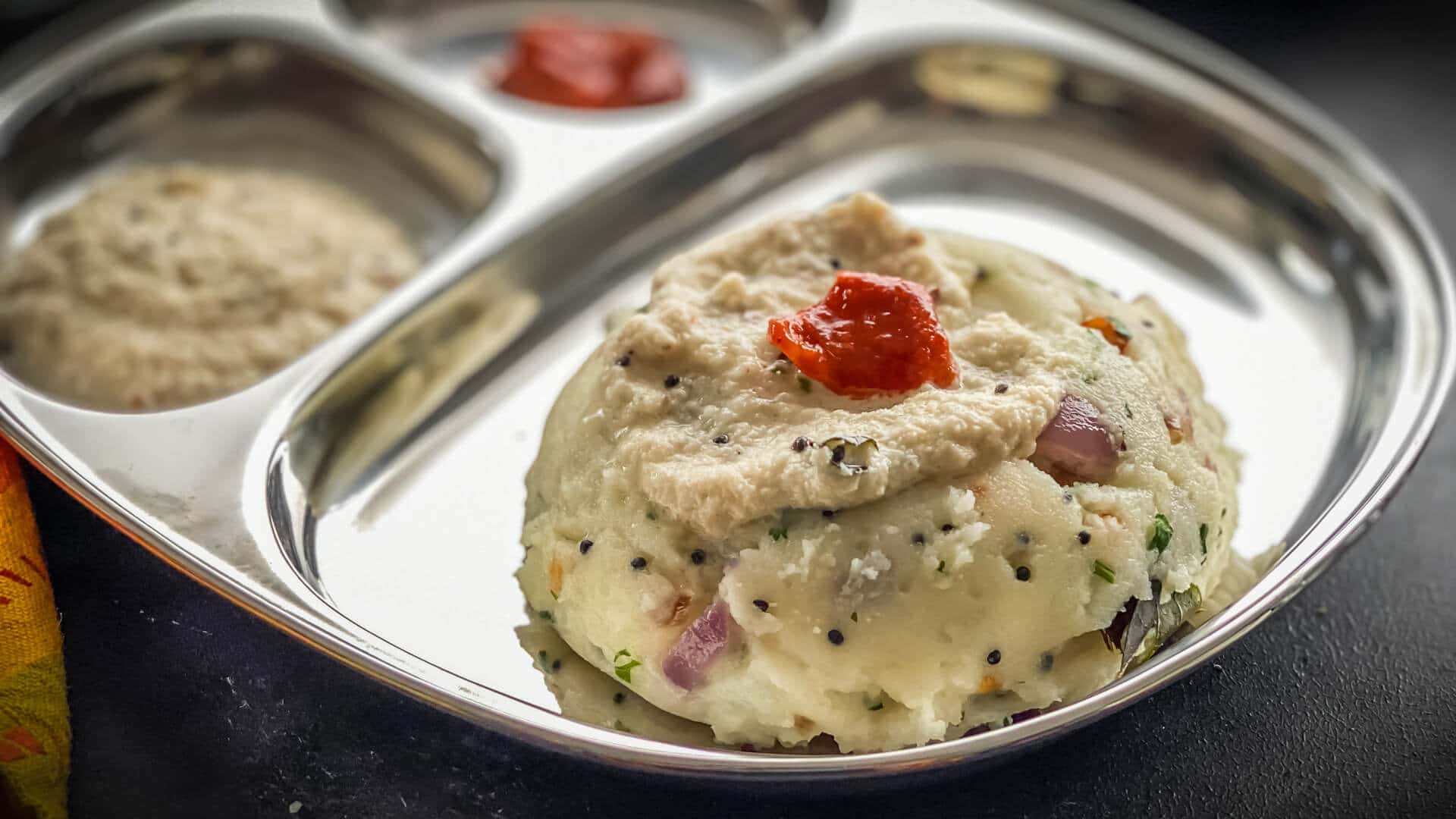
Here’s what you need to make the recipe
Ingredient notes/swaps
- Semolina / rava – I prefer woody semolina (Bombay rava), but you can moreover use Bansi rava (fine rava)
- Hot water – to melt the semolina
Tempering
- Oil/ghee – I either use avocado oil or ghee. You can use any oil of your choice.
- Onions – finely chopped.
- Mustard seeds
- Curry leaves – a sprig of these flavorful leaves
- Urad dal (split woebegone gram) and chana dal (split Bengal gram)
- Ginger – finely grated
- Cashew nuts – for widow crunch and taste
Other ingredients
- salt and sugar
Finish off with
- Ghee – for savor
- Cilantro/coriander leaves
- Grated coconut (optional)
- Lime juice – along with the sugar, gives the upma a nice flavor.
Be sure to trammels out the full recipe and ingredient list below.
How to make upma
There are two ways to make upma – one way is to make it moist, and the other version is dry, fluffy, and crumbly, very much like the suji halwa (sweet semolina pudding). My mom used to make the drier version which I was not a huge fan of (sorry, Mom!).
My dislike for upma unfurled into womanhood until I came wideness this soft and moist version in a Udupi restaurant. The upma they served was very moist (those melt-in-the-mouth kinds) and was accompanied by coconut chutney and sambar.
I wondered what was variegated from the other versions I have had before, and I realized it came lanugo to three things – the moist texture, a tad bit of ghee, and a generous value of coriander mixed in while cooking.
Step-by-step instructions to make rava upma
- In a saucepan, add 3 cups of water and let it come to a boil.
- Meanwhile, heat oil (or ghee if using) in a medium-sized wok kept over medium heat, and then add mustard seeds.
- As they uncork to crackle, add curry leaves, urad dal, and cashews(if using). Fry them for a minute.
- Add grated ginger, chopped chilies, and onions. Fry the onion till they are translucent. Add salt and sugar. Mix well.
- Reduce the heat to medium-low. Add sooji and protract frying till it starts to transpiration to a light golden brown verisimilitude and a sweet zephyr emanates from the mixture (approximately 6-8 minutes).
- Add hot water thoughtfully to the semolina mixture and alimony stirring the upma as you add water to ensure it is lump-free.
- Lower the gas to a simmer. Cover and melt for 2 minutes until all the water is undivided and the sooji mixture is moist but not dry.
- Add ghee, lime juice, and cilantro and mix them in.
- Take the wok off the heat and serve upma hot as is or accompanied by chutney, pickle, or sambar.
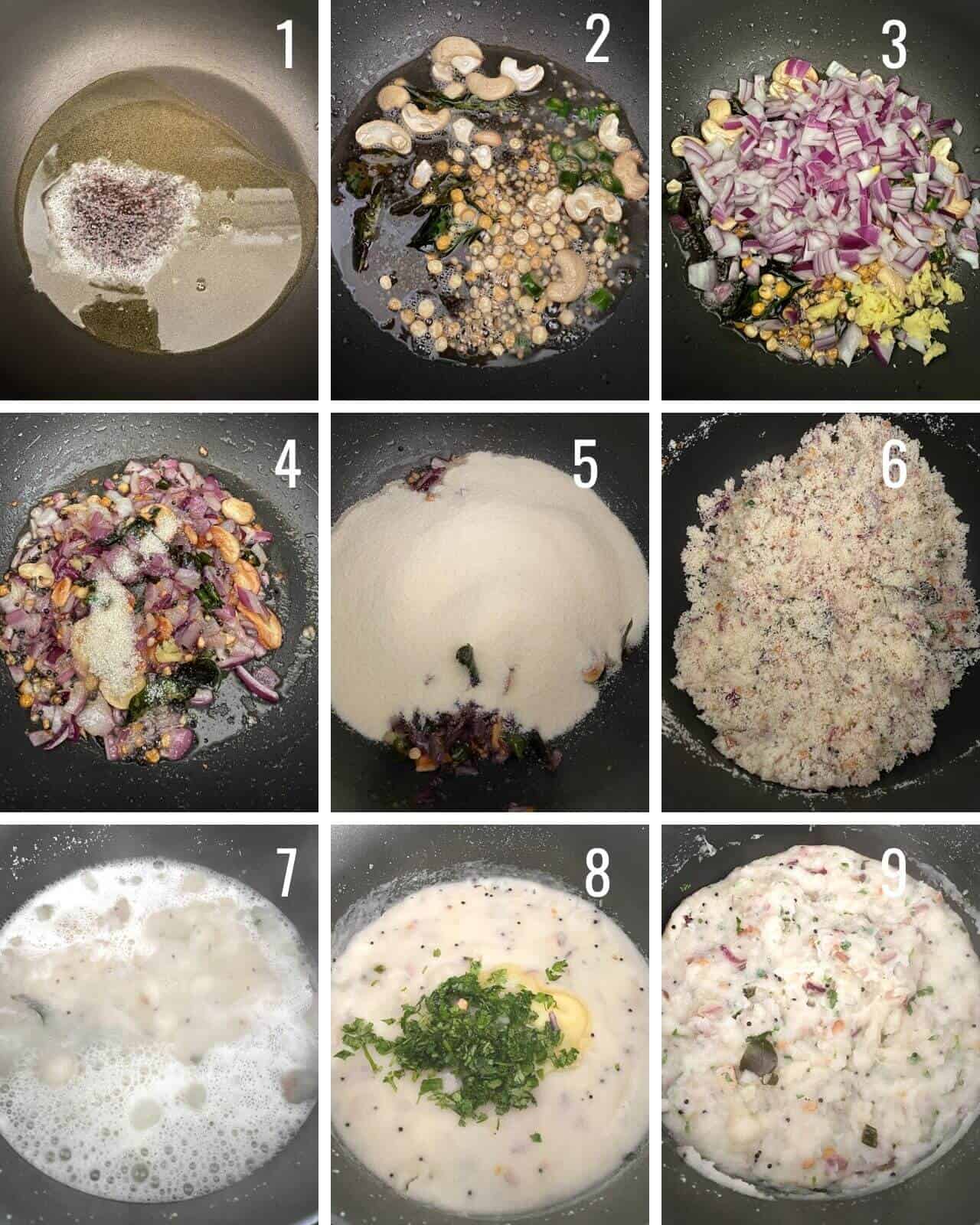
Traditional sooji upma recipe
Note: Traditionally, the process of making upma is slightly variegated (see below). I like my process listed whilom largest considering it is faster and tastes just as good 
- Dry roast the semolina in medium-low heat in a wok till it turns whiffy (6-8 minutes). Transfer the semolina to a plate.
- Then to the same wok, add oil or ghee. Set the heat to medium. Once the oil/ghee has been heated, add mustard seeds.
- As they uncork to crackle, add curry leaves, urad dal, chana dal, and cashews(if using). Fry them for a minute.
- Add grated ginger, chopped chilies, and onions. Fry the onions till they are translucent. Add salt and sugar. Mix well.
- Add water to the onions. Let the water come to a boil, and then add the roasted semolina, a few tablespoons at a time. Stir continuously to stave lumps.
- Lower the gas to a simmer. Cover and melt for 2 minutes until all the water is undivided and the sooji mixture is moist but not dry.
- Add ghee, lime juice, and cilantro and mix them in.
- Take the wok off the heat and serve upma hot as is or accompanied by chutney, pickle, or sambar.
Tips to stave lumpy/sticky upma
Tester’s notes
- Roast the rava on medium-low heat till they turn aromatic.
- Follow the right water ratio: Use a 1:3 ratio, i.e., for every cup of semolina, use 3 cups of water. If you prefer it increasingly crumbly and dry, use 2.5 cups of water instead of 3.
- Constant stirring: Reduce the gas to low, and constantly stir when introducing upma with water.
- Bonus tip for flavor: When the rava is washed-up cooking, add a tablespoon of ghee and chopped cilantro. Mix them well and take the upma off the heat immediately.
Variations to try
- Vegetable rava upma – You can moreover add veggies such as tomatoes, untried peas, and chopped carrots to this dish. After the onions turn soft, add well-nigh 1/4 cup each of finely chopped tomatoes, peas, and carrots. Saute them till they are cooked through. Add the rava and follow the rest of the steps in the recipe vellum below.
- You could top this dish once cooked with some freshly grated coconut to mix it up.
- To make it vegan, replace ghee with coconut oil.
- Finish off with lime juice – once the cooking is completed, add well-nigh a tablespoon of freshly squeezed lime juice withal with cilantro for widow flavor.
How to prep ahead
One way is to make the instant rava upma mix, as shared below. The other way is to merely roast the rava in advance. Let the roasted rava tomfool and store it in an snapped container for up to 6 months. Don’t need to roast the rava then when you make upma – this should shave 6-8 minutes from your total cooking time.
Instant Rava Upma Mix
Have you heard of the Instant upma mix? It is just like instant oatmeal, where you need to add hot water to the mix, and it is ready to eat. The mix lasts for well-nigh a week, unrefrigerated, and for well-nigh a month in the fridge, making it platonic for traveling or for when you want a quick breakfast or snack.
Here’s how to make the Instant rava upma mix –
- Skip the onions – using them decreases the shelf life of this mix.
- Meanwhile, heat oil (or ghee if using) in a medium-sized wok kept over medium heat, and then add mustard seeds.
- As they uncork to crackle, add curry leaves, urad dal, chana dal, and cashews(if using). Fry them for a minute till the curry leaves are crisp.
- Add grated ginger and chopped chilies. Add salt and sugar. Mix well.
- Add sooji and protract frying till it turns light brown and a sweet zephyr emanates from the mixture (approximately 6-8 minutes).
- Once the semolina is roasted, turn off the heat.
- Allow the mixture to tomfool lanugo completely surpassing storing it in either glass containers or Ziploc bags.
- Add hot water to the mix for a quick breakfast, stir, and enjoy. For every cup of premade mix, use 3 cups of hot water.
Storage tips
Refrigerator: Store any leftover rava upma in an air-tight container in the refrigerator for up to 2-3 days.
Freezer: Tomfool the upma completely surpassing freezing it in a freezer-safe container. Surpassing reheating, thaw overnight in the refrigerator for weightier results.
Reheat: To reheat, sprinkle a few drops of water (if the upma looks very dry) and mix well. Microwave it for 30-60 seconds until heated through.
Serve it with
Upma is weightier served as a breakfast or a snack with some coconut chutney on the side and a cup of hot South Indian freshly spirituous coffee to trailblaze it.
However, it can be served with other chutneys, pickles, yogurt, and sometimes plane sambar. Some people like to eat it with a little sugar too.
Some South Indian restaurants often pair sooji upma with kesari bhaat, a sweet dish. This particular combination of upma and kesari bhat is tabbed chowchow bhat.
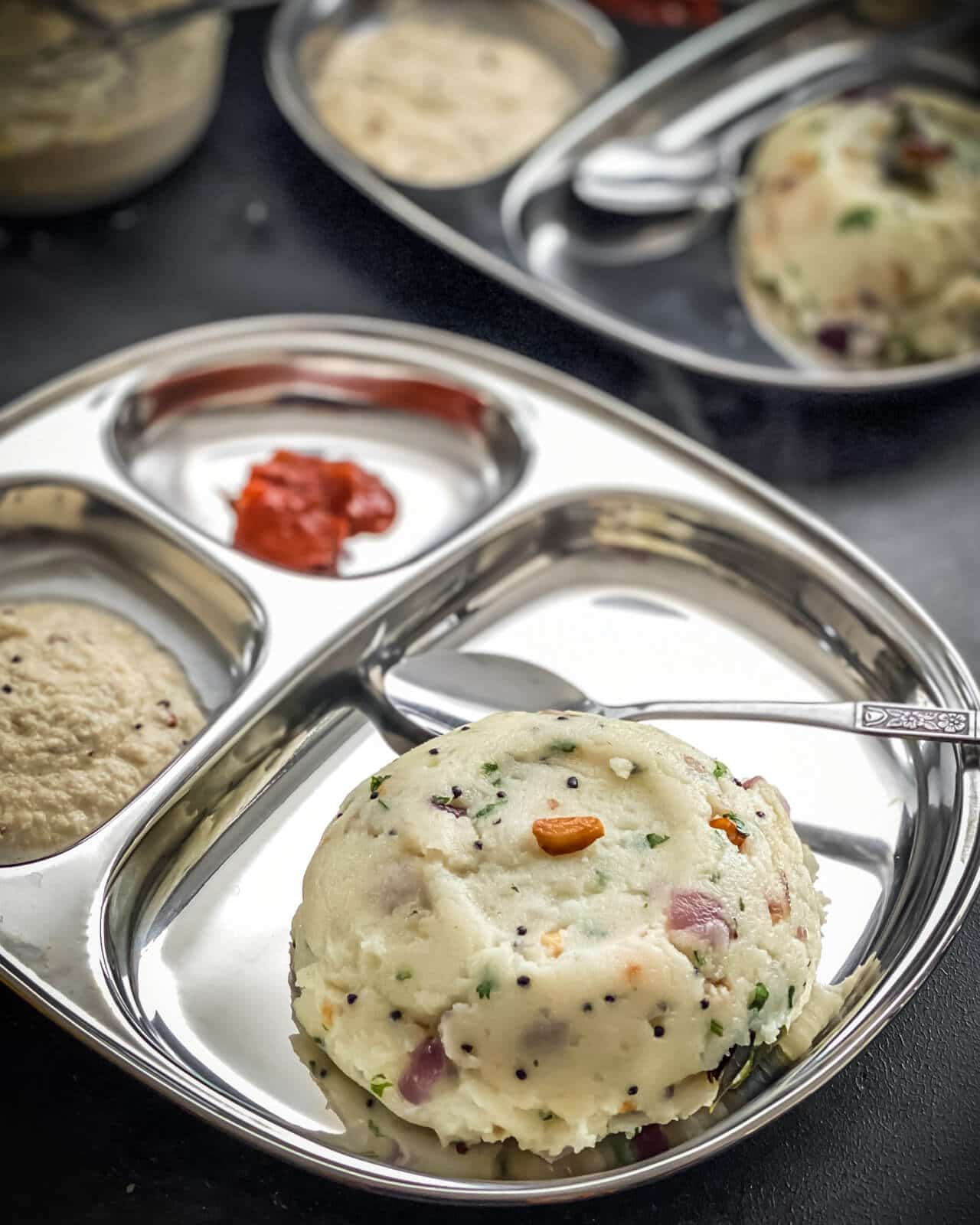

Frequently asked questions
For crumbly, fluffy upma, use the ratio 1:2.5, i.e., for every cup of rava, use 2.5 cups water. If you prefer soft, melt-in-the-mouth restaurant-style upma, use a 1:3 ratio, i.e., for every cup of rava, use 3 cups of water.
Continue cooking the upma on medium-low heat till the water is absorbed.
Upma becomes sticky when the semolina or rava has not been roasted properly and if you widow increasingly water than needed. To make fluffy, non-sticky upma, you should roast the semolina properly, and add hot water in a ratio of 1:2.5 i.e., for every cup of rava, use 2.5 cups of water.
To stave lumpy upma, here are a few things you should do – roast the semolina properly, reduce the gas to medium-low, and constantly stir when introducing upma with water; make sure you follow the right ratio of water to upma. To fix lumpy upma, add hot water to the upma (the value will vary, so start with 1/2 cup), unravel the lumps, and melt on low heat.
Other easy breakfast recipes to try
Hope you liked this upma recipe, and if you are looking for easy and succulent breakfast recipes, here are my reader favorites –
- Semiya Upma (Lemon Vermicelli) – This succulent and tangy South Indian breakfast dish is just what you need to start your day. It is filling and comes together in 15 minutes from start to finish.
- Idli – You’ll love this post if you struggle to get soft and spongy idlis. Learn all my tips and tricks to get perfect fermented thrash plane in winter!
- Buttermilk dosa – Succulent and soft, this dosa is perfect for breakfast, snacks, and plane lunch. Learn how to make it in a few easy steps.
- Bread upma – Savory, filling, and quick to make, this south Indian style specie upma recipe comes together in 20 minutes for a cozy and satisfying breakfast.
- Non-Sticky Sabudana Khichdi – This step-by-step recipe will show you how to make sabudana khichdi that looks as unconfined as it tastes. No increasingly clumpy or sticky mess!
EASY BREAKFAST RECIPES
35 Indian Breakfast Recipes
Running out of ideas on what to make for breakfast? Here’s a list of easy Indian breakfast recipes for your inspiration so that you are never bored eating the same things over and over.
This recipe rocks because..
You’ll get the same taste and texture of restaurant-style rava upma but with fewer steps!
Restaurant-Style Rava / Sooji Upma Recipe
Ingredients
- 3 cups water
- 2 tablespoons ghee or oil
- ½ teaspoon mustard seeds
- 1 sprig of curry leaves or kadipatta kadipatta roughly 10-12 leaves
- 1 teaspoon urad dal
- 1 teaspoon chana dal
- 1 teaspoon cashew nuts chopped finely
- 2 Indian or Thai untried chilies (Bird’s eye) slit lengthwise
- ½ cup chopped onions
- 1 teaspoon grated ginger
- 1 teaspoon sugar
- 1.5 teaspoons salt or to taste
- 1 cup sooji / rava semolina / Bombay rava
- 1 tablespoon ghee optional
- 1 tablespoon lime juice optional
- 1 tablespoon finely chopped cilantro / coriander leaves for garnishing
Instructions
- In a saucepan, add 3 cups of water and let it come to boil.3 cups water
- Meanwhile, heat oil (or ghee if using) in a medium-sized wok kept over medium heat and then add mustard seeds.2 tablespoons ghee, 1/2 teaspoon mustard seeds
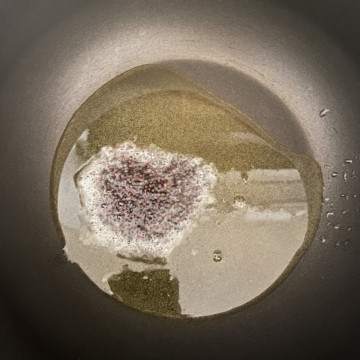
- As they uncork to crackle, add curry leaves, urad dal, chana dal and cashews(if using). Fry them for a minute.1 sprig of curry leaves or kadipatta, 1 teaspoon urad dal, 1 teaspoon chana dal, 1 teaspoon cashew nuts
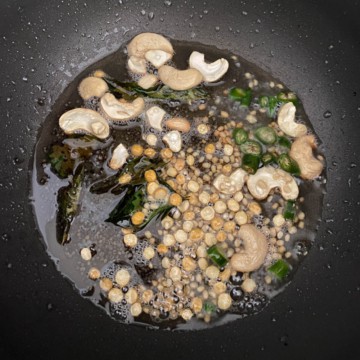
- Add grated ginger, chopped chilies, and onions.2 Indian or Thai untried chilies (Bird’s eye), 1/2 cup chopped onions, 1 teaspoon grated ginger
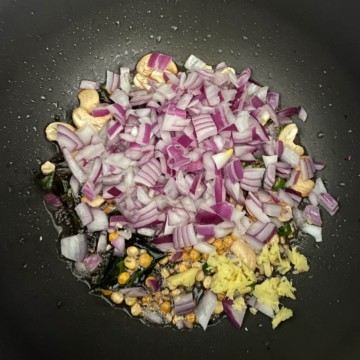
- Fry the onions till they are translucent. Add salt and sugar. Mix well.1 teaspoon sugar, 1.5 teaspoons salt
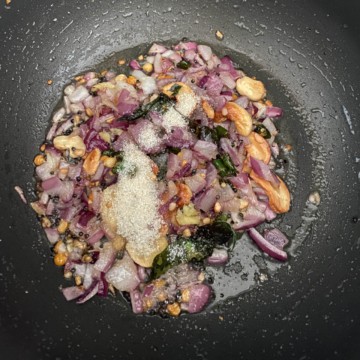
- Reduce the heat to medium-low. Add sooji and mix well.1 cup sooji / rava
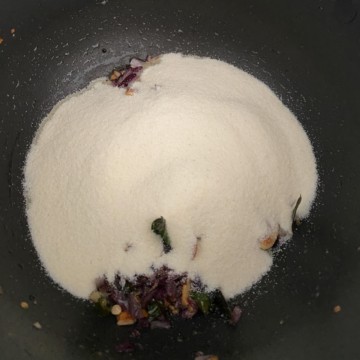
- Continue frying till it starts to transpiration to a light golden brown verisimilitude and a sweet zephyr emanates from the mixture (approximately 6-8 minutes).
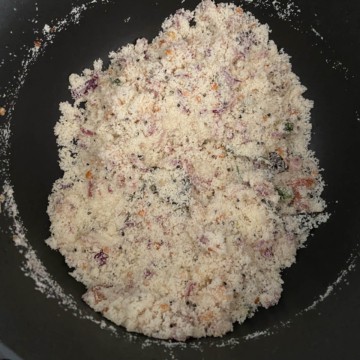
- Add hot water thoughtfully to the semolina mixture and mix well to make sure it is lump-free.
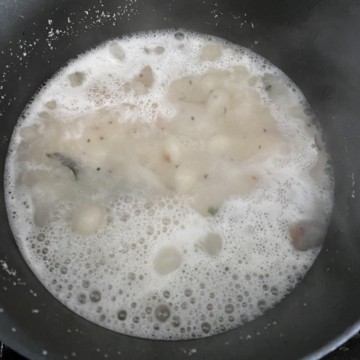
- Lower the gas to a simmer. Cover and melt for 2 minutes until all the water is undivided and the sooji mixture is moist but not dry. Add ghee, lime juice and cilantro and mix them in.1 tablespoon ghee, 1 tablespoon finely chopped cilantro / coriander leaves for garnishing, 1 tablespoon lime juice
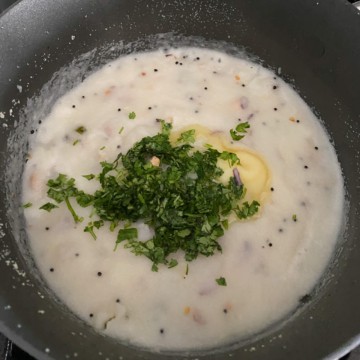
- Take the wok off the heat and serve upma hot as is or accompanied by chutney, pickle, or sambar.
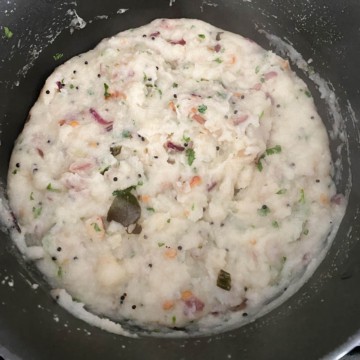
Notes
- Follow the 1:3 ratio, i.e. for every cup of semolina, use 3 cups of water. If you prefer it increasingly crumbly and dry, use 2.5 cups of water instead of 3.
- When the rava is washed-up cooking, add a tablespoon of ghee and chopped cilantro. Mix them well and take the upma off the heat immediately.
Note: Traditionally, the process of making upma is slightly different, as noted below. I like my process listed whilom largest considering it is faster and tastes just as good

- Dry roast the semolina in medium-low heat in a wok till it turns whiffy (6-8 minutes). Transfer the semolina to a plate.
- Then to the same wok, add oil or ghee. Set the heat to medium. Once the oil/ghee has been heated, add mustard seeds.
- As they uncork to crackle, add curry leaves, urad dal, chana dal, and cashews(if using). Fry them for a minute.
- Add grated ginger, chopped chilies, and onions. Fry the onions till they are translucent. Add salt and sugar. Mix well.
- Add water to the onions. Let the water come to a boil, and then add the roasted semolina, a few tablespoons at a time. Stir continuously to stave lumps.
- Lower the gas to a simmer. Cover and melt for 2 minutes until all the water is undivided and the sooji mixture is moist but not dry.
- Add ghee, lime juice, and cilantro and mix them in.
- Take the wok off the heat and serve upma hot as is or accompanied by chutney, pickle, or sambar.
Variations
- You can moreover add veggies such as tomatoes, peas, and carrots to this dish. After the onions turn soft, add well-nigh 1/4 cup each of finely chopped tomatoes, peas, and finely chopped carrots. Saute them till they are cooked through.
- You could top this dish once cooked with some freshly grated coconut to mix it up.
- To make it vegan, replace ghee with coconut oil.
- Finish off with lime juice – once the cooking is completed, add well-nigh a tablespoon of freshly squeezed lime juice withal with cilantro for widow flavor.
Nutrition
This post was originally published on 2/16/2014 and was completely updated with pictures on 5/15/2020 and with new text and step by step images on 5/3/2023.
